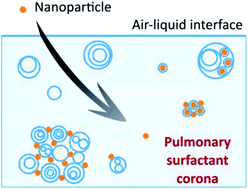当前位置:
X-MOL 学术
›
Nanoscale Adv.
›
论文详情
Our official English website, www.x-mol.net, welcomes your
feedback! (Note: you will need to create a separate account there.)
Revealing the pulmonary surfactant corona on silica nanoparticles by cryo-transmission electron microscopy
Nanoscale Advances ( IF 4.6 ) Pub Date : 2020/01/07 , DOI: 10.1039/c9na00779b Fanny Mousseau 1 , Evdokia K Oikonomou 1 , Annie Vacher 2 , Marc Airiau 2 , Stéphane Mornet 3 , Jean-François Berret 1
Nanoscale Advances ( IF 4.6 ) Pub Date : 2020/01/07 , DOI: 10.1039/c9na00779b Fanny Mousseau 1 , Evdokia K Oikonomou 1 , Annie Vacher 2 , Marc Airiau 2 , Stéphane Mornet 3 , Jean-François Berret 1
Affiliation

|
When inhaled, nanoparticles (NPs) deposit in alveoli and transit through the pulmonary surfactant (PS), a biofluid made of proteins and phospholipid vesicles. They form a corona reflecting the PS–nanomaterial interaction. Since the corona determines directly the NPs' biological fate, the question of its nature and structure is central. Here, we report on the corona architecture formed after incubation of positive or negative silica particles with Curosurf®, a biomimetic pulmonary surfactant of porcine origin. Using optical, electron and cryo-electron microscopy (cryo-TEM), we determine the pulmonary surfactant corona structure at different scales of observation. Contrary to common belief, the PS corona is not only constituted by phospholipid bilayers surrounding NPs but also by multiple hybrid structures derived from NP–vesicle interaction. Statistical analysis of cryo-TEM images provides interesting highlights about the nature of the corona depending on the particle charge. The influence of Curosurf® pre- or post-treatment is also investigated and demonstrates the need for protocol standardization.
中文翻译:

通过低温透射电子显微镜揭示二氧化硅纳米颗粒上的肺表面活性剂电晕
吸入时,纳米颗粒 (NPs) 沉积在肺泡中并通过肺表面活性剂 (PS),这是一种由蛋白质和磷脂囊泡组成的生物流体。它们形成反映 PS-纳米材料相互作用的电晕。由于日冕直接决定了 NPs 的生物学命运,因此其性质和结构问题是中心问题。在这里,我们报告了在正或负二氧化硅颗粒与猪源仿生肺表面活性剂 Curosurf® 孵育后形成的电晕结构。使用光学、电子和低温电子显微镜 (cryo-TEM),我们确定了不同观察尺度下的肺表面活性剂电晕结构。与普遍看法相反,PS 冠不仅由围绕 NP 的磷脂双层构成,而且还由源自 NP-囊泡相互作用的多个混合结构构成。低温 TEM 图像的统计分析提供了有关取决于粒子电荷的电晕性质的有趣亮点。还研究了 Curosurf® 治疗前或治疗后的影响,并证明了协议标准化的必要性。
更新日期:2020-02-19
中文翻译:

通过低温透射电子显微镜揭示二氧化硅纳米颗粒上的肺表面活性剂电晕
吸入时,纳米颗粒 (NPs) 沉积在肺泡中并通过肺表面活性剂 (PS),这是一种由蛋白质和磷脂囊泡组成的生物流体。它们形成反映 PS-纳米材料相互作用的电晕。由于日冕直接决定了 NPs 的生物学命运,因此其性质和结构问题是中心问题。在这里,我们报告了在正或负二氧化硅颗粒与猪源仿生肺表面活性剂 Curosurf® 孵育后形成的电晕结构。使用光学、电子和低温电子显微镜 (cryo-TEM),我们确定了不同观察尺度下的肺表面活性剂电晕结构。与普遍看法相反,PS 冠不仅由围绕 NP 的磷脂双层构成,而且还由源自 NP-囊泡相互作用的多个混合结构构成。低温 TEM 图像的统计分析提供了有关取决于粒子电荷的电晕性质的有趣亮点。还研究了 Curosurf® 治疗前或治疗后的影响,并证明了协议标准化的必要性。











































 京公网安备 11010802027423号
京公网安备 11010802027423号